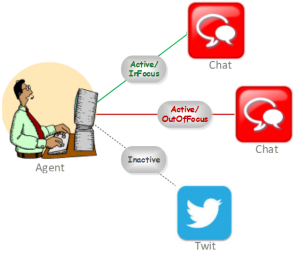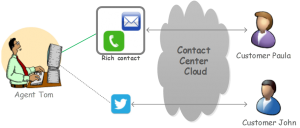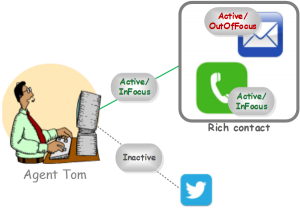Challenges and approaches for distribution of multi-channel interactions and associated reporting in a contact center
It is known from the ancient history that Gaius Julius Caesar, a dictator in ancient Rome, could do many things at the same time – talk to somebody, read, write and dictate up to four letters to his secretary. Nowadays agents of contemporary multi-channel contact centers could do even more – chat with several customers at once, work with emails, knowledge base and other agent applications.
“Aberdeen research shows that 99% of businesses use at least two channels to interact with clients.” (Aberdeen Group: MULTI – CHANNEL IN THE CONTACT CENTER: CHANNEL ADOPTION VARIES FROM USAGE, by Omer Minkara, November 2014.)
How can we make sure that all agents are occupied properly in a multi-channel environment? What interaction could be distributed to an agent who is already working with some other interactions and what could not? How to calculate agent occupancy and how to ensure fair routing? How to define agent capacity to handle different interactions simultaneously? How to report on such simultaneous activities?
A Case of Multiple Multi-Channel Interactions
In contemporary multichannel contact centers each agent must be able to handle multiple customer interactions across different channels simultaneously. Indeed, this substantially increases contact center performance by improving agent productivity and utilization because agents can now serve several customers simultaneously.
“Aberdeen’s study shows that more than half of all contact centers today use at least six channels (e.g. phone, IVR, social media, web, email, and mail or fax) to listen to and engage their clients.” (Aberdeen Group: Multi-Channel Contact center: Delight Customers where they Live, by Omer Minkara, November 2012.)
Applying conventional routing and reporting techniques to multichannel interactions does not help anymore. Indeed, an agent who processes one interaction will be considered as busy and no other interactions will be distributed to her. Let’s consider two cases where routing multiple interactions is desired.
First, suppose an agent, assigned to work with voice calls and emails, receives an email and works with it. The agent could not receive a new voice call because he/she is considered busy by the router. At the same time it would be reasonable to distribute voice calls to agents who work with emails because voice calls cannot wait while emails could be deferred for a while.
Second, if an agent works with a chat session he/she cannot receive another chat. Again the router treats the agent as busy who cannot be interrupted by another interaction. In real life, though, an agent who works with chat spends a portion of their time waiting for the customer’s response. Normally, a well-trained agent is able to successively work with two or even more chat sessions at a time without sacrificing the quality of service.

To cope with these and other problems, I suggest using the interruption matrix. An example of an interruption matrix is presented below. The example matrix describes relationships between five media channels – voice, email, chat, twitter, and SMS.
The first row of the matrix contains only “No” cells that say that a voice interaction cannot be interrupted by other interactions. This means, for example, that if a contact center has a new chat interaction, they cannot distribute it to an agent who is handling a voice call. The second row says that if an agent handles an email he could receive a voice call or a chat session. The third row specifies availability of an agent handling a chat session. No interaction of any other type can interrupt an agent participating in a chat session except another chat. When an agent is allowed to process several interactions at a time we should specify a maximum number. Here the maximum number is set to 2 meaning at most two chat sessions. The other rows corresponding to twitter and SMS are similar to email. Both could be interrupted by voice or chat interactions only.
The matrix could be easily extended by adding more interaction media types. The general principle here is to avoid interrupting real-time interactions with live customers who cannot wait.
The matrix could be customized based on the nature of business or abilities of specific agents. Sometimes it is reasonable to distribute more than one email to an agent thus reducing time between interactions. Some agents are able to handle more than two chats without sacrificing quality.
It should be noted that the matrix does not say how an agent will process several distributed interactions. When they have email and voice they will work with voice, and, after the call’s completion, will return to email. In case of several chat sessions the agent is periodically switching from one chat to another one. Clearly, contact centers need a mechanism to determine and report an agent activity on a more granular level. Otherwise the agent occupancy could exceed 100% because handling times of all parallel interactions will be aggregated straightforwardly.
To provide such a mechanism it’s best to employ a notion of agent focus – a pointer to an interaction the agent is actually working with at each moment of time. This pointer is shifted from one interaction to another one while the agent switches their attention. Clearly, an agent desktop tool should be equipped with an ability to capture this focus shift.

The next figure illustrates the notion of agent focus. The agent is working with three interactions at once – two chat sessions and one tweet message. At the moment the agent is handling the upper chat interaction and it is in “Active/InFocus” state. The second chat is waiting for the agent’s attention and is in “Active/OutOfFocus” state. The tweet message is deferred and therefore is set into “Inactive” state.
Using this model contact centers could easily calculate core agent metrics. For example agent occupancy could be calculated using the sum of time when the agent was in “Active/InFocus” state. Clearly the occupancy then will not exceed 100%. If this statistic is calculated in real time, it could be used for routing inbound interactions to distribute interactions to agents who are less occupied.
Bundling Interactions for Rich Contact Experience
The media interruption matrix and agent focus model covered in the previous section are very simple and powerful tools for managing and monitoring agent behavior in multichannel environment. However there are cases when they cannot help.
Let’s consider a situation when an agent is handling a customer call. It is reasonable to have an interruption matrix that prevents a distribution of other interactions to that agent. But imagine an email comes from the same customer related to the problem the agent and the customer are discussing. In accordance with the interruption matrix the system will distribute this email to another agent that will result in confusion. More sophisticated routing means are needed that will take the customer into consideration.
Fortunately, such a mechanism exists as a part of rich contact experience concept. In this concept, all interactions belonging to the same customer are grouped together forming a rich contact, a super interaction. The following Figure illustrates this concept.

We can see that agent Tom is working with two customers -Paula and John. More specifically, he handles John’s tweet interaction and Paula’s rich contact. Paula’s contact comprises of two interactions – email and voice call. Both interactions of the contact relate to the same customer and topic and therefore share the same context. The rich contact could evolve with new interactions being created and completed within it. For example, Paula sends some pictures using an application on her smartphone. As a result, a new interaction is created and distributed directly to Tom as an existing party in Paula’s conversation.
A rich contact becomes a unit of manipulation with customer interactions. For example if Tom decides to transfer the contact to another agent, the contact with all its interactions will be transferred.
In some cases an ordinary interaction may be converted to a rich contact. For example, agent Tom reads John’s tweet message and founds it to be very important. He decides to contact John by voice and makes a call to him to discuss the problem in more detail.
Notice in the example agent Tom also works with a tweet message from John. But this interaction is in inactive state waiting for Tom to finish working with Paula.

A rich contact could be perceived as a super-interaction and be placed into the interruption matrix along with conventional interactions. In that case, when we define the matrix values we should take into consideration its importance in comparison with other simple interactions. In the example below, I defined a rich contact as a super-interaction with the highest priority that could interrupt any interaction but cannot be interrupted by the others.
Assigning the highest priority to a rich contact is reasonable because in this case a customer is better identified, his/her needs are clearer, and, what is more important, the rich contact could potentially be expanded with other interactions which may require more attention from the agent.
To monitor and report the agent’s behavior in a multichannel and rich contact environment contact centers can easily extend the notion of focus allowing an agent to be focused on rich contacts. The next figure demonstrates the approach.

Agent Tom has one rich contact and one tweet interaction. Currently Tom works with the rich contact and therefore his focus is on the contact in state “Active/InFocus”. The focus of tweet message is in state “Inactive”.
Within the contact Tom’s focus is on voice call because he talks to the customer. The email is in “Active/OutOfFocus” state because the agent does not directly handle it but uses its context.
“Contact centers without omni-channel capabilities are twice as likely to incur increases in customer service costs” (Aberdeen Group: OMNI-CHANNEL CONTACT CENTER: THE SMARTER WAY TO ENGAGE CUSTOMERS by Omer Minkara, November 2014.)
In this article, I have introduced mechanisms for assigning several multichannel interactions to one agent and proposed a way to monitor and to report his/her performance. The mechanisms were then applied to a rich contact experience interaction. The mechanism could be adapted to interactions and rich contacts with priorities. But this is another story.



